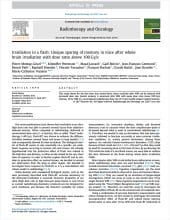Background
This study shows for the first time that normal brain tissue toxicities after WBI can be reduced with increased dose rate. Spatial memory is preserved after WBI with mean dose rates above 100 Gy/s, whereas 10 Gy WBI at a conventional radiotherapy dose rate (0.1 Gy/s) totally impairs spatial memory.
Material & methods
Irradiation was performed using prototype electron beam linear accelerators (LINACs) of type Oriatron 6e (6 MeV) and Kinetron (4.5 MeV) (PMB-Alcen, Peynier, France). This LINAC is able to produce electron beams at a mean dose rate ranging from 0.1 Gy/s (=6 Gy/min, i.e. similar to dose rates conventionally used for radiotherapy) to 1000 Gy/s, corresponding to a dose, in each electron pulse, ranging between 0.01 and 10 Gy. This wide range of dose rate is made possible by varying the linac gun grid tension, the pulse repetition frequency, pulse width, and the source-to-surface distance (SSD).
Results
The absorbed dose measurements carried out at the surface of the solid water phantom for the various types of dosimeters showed that 10 Gy was accurately delivered, at the different dose rates used (Fig. S2 in Sup.). The TLD measurements in the brain of the mouse cadaver validated that 10 Gy was actually the dose delivered to the brain for the prescription of 10 Gy WBI, for the highest (10 Gy in a single 1.8 ls pulse) and the lowest dose rate (0.1 Gy/s) used in this study (Fig. 1a and b). The measured absorbed dose in the brain was 10 Gy (10.06 and 9.90 ± 8.2%, k = 2) in the center of the brain (proximal measurements) and slightly below 10 Gy (lateral left: 9.62 and 9.29 ± 8.2%, lateral right 9.56 and 9.72 ± 8.2%, k = 2) at the edge of the brain (lateral measurements in Fig. 1b)
Conclusion
We have for the first time been able to show that the damage to normal brain tissue, for a given absorbed dose of 10 Gy, can be reduced simply by increasing the dose rate to values 1000 times above what is used in conventional radiotherapy treatments. These unique results show a preservation of memory two months after a 10 Gy WBI with dose rates above 100 Gy/s, whereas 10 Gy WBI at a conventional radiotherapy dose rate (0.1 Gy/s) totally impaired memory.
*Ultra-High Dose Rate (UHDR) functionality for FLASH Radiotherapy is for investigational use only and is not cleared for sale by the US FDA.
